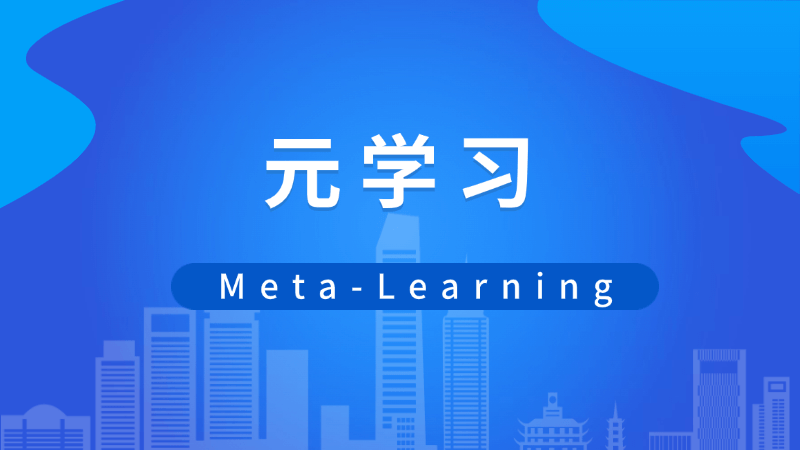What is Meta-Learning (Meta-Learning) in one article?
Definition of meta-learning
Meta-Learning, or learning how to learn, is an important branch of the machine learning field that focuses on developing learning algorithms that can quickly adapt to new tasks. While traditional machine learning models are trained for specific tasks and require large amounts of data and computational resources, meta-learning allows models to extract generalized knowledge from multiple related tasks and learn efficiently when faced with a new task with only a small number of samples or experiences. This capability is similar to the way humans learn, who can quickly master new skills based on previous experience without having to start from scratch.
The core idea of meta-learning is that through the meta-training process, the model learns how to adjust its own parameters or strategies to optimize its performance in new environments. For example, in a sample less learning scenario, a meta-learning model can recognize new patterns from a handful of examples, greatly enhancing the flexibility and usefulness of AI. Meta-learning is not limited to computer science, but also permeates education, psychology and neuroscience, providing new perspectives for understanding the nature of intelligence. By modeling the learning process itself, meta-learning pushes AI in the direction of greater generality and autonomy, and becomes one of the key steps in realizing artificial general intelligence.

Historical background of meta-learning
The concept of meta-learning is not entirely new, and its roots can be traced to developments in several disciplines in the second half of the 20th century. Early ideas sprouted in artificial intelligence and cognitive science, and gradually took shape as technology progressed.
- 1980s:Researchers began to explore the idea of "learning to learn", inspired by human cognition, in an attempt to get machines to mimic this ability. John Hollander's work on genetic algorithms laid the groundwork for adaptive systems, but meta-learning had not yet matured as a separate field.
- 1990s:With the revival of neural networks, meta-learning has gained more attention. Jürgen Schmidhuber's proposal of "meta-learning networks", which allow models to learn their own learning process through a recursive architecture, is regarded as the forerunner of modern meta-learning. At the same time, Bayesian methods were introduced to provide a framework for learning under uncertainty.
- Early 2000s:Growth in computational resources drives empirical research. The problem of learning with fewer samples came into focus, and meta-learning was applied to image classification and natural language processing to help models generalize from limited data. For example, a 2003 paper first formalized meta-learning as an optimization problem.
- 2010s:The deep learning explosion has accelerated meta-learning advances. Algorithms like model-agnostic meta-learning (MAML) emerged to make meta-learning more practical and scalable.In 2017, the release of MAML marked a turning point, allowing any model to be quickly adapted to a new task via gradient updates.
- In recent years:Meta-learning extends to reinforcement learning and robotics to solve real-world problems such as autonomous driving and personalized medicine. History has shown that meta-learning is the product of interdisciplinary collaboration, constantly incorporating insights from psychology and neuroscience, and has great potential for the future.
Core concepts of meta-learning
Meta-learning builds on several key ideas that distinguish it from traditional machine learning and explain its efficiency.
- Meta-training and meta-testing:The meta-learning process is divided into two phases. A meta-training phase, where the model is exposed to multiple related tasks to learn shared representations or strategies; and a meta-testing phase, where the model applies what it has learned to a completely new task and evaluates the ability to adapt. This two-phase design simulates the human process of learning from experience and then applying it.
- Less Sample Learning:Meta-learning is often combined with few-sample learning, where the goal is to learn quickly from a very small number of samples (e.g., a few examples). This addresses the problem of data scarcity, for example in medical diagnostics, where models can recognize disease patterns from a small number of cases.
- Task Distribution:Meta-learning assumes that the task comes from a distribution and the model learns the commonalities of that distribution through meta-training. For example, in language processing, the task may be to translate different language pairs, and the model learns the common language structure to quickly process new language pairs.
- Optimize the foundation:Meta-learning algorithms optimize models for fast adaptation rather than directly optimizing task performance. Methods such as MAML are updated via inner and outer loops: inner loops fine-tune for specific tasks, and outer loops adjust meta-parameters for more efficient fine-tuning.
- Indicates learning:Meta-learning emphasizes learning transferable representations, i.e., features or knowledge, applicable to multiple tasks. This is analogous to humans mastering basic concepts and then applying them to new domains, enhancing generalization without relearning.
Application areas of meta-learning
The utility of meta-learning is reflected in multiple domains, driving technological innovation and practical solutions.
- Artificial Intelligence and Machine Learning:In AI, meta-learning is used for less-sample image classification, speech recognition, and game AI. for example, OpenAI uses meta-learning to allow AI intelligences to adapt quickly to new game rules, reducing training time and resource consumption.
- Educational Technology:Meta-learning is applied to personalized learning systems to adjust teaching strategies after analyzing student behavioral data. The platform utilizes meta-learning algorithms to recommend learning paths that help students efficiently master new knowledge based on past performance.
- Healthcare:In healthcare, meta-learning aids diagnosis and treatment planning. From a small number of medical images, models can identify rare diseases or predict molecular properties in drug discovery, accelerating the R&D process.
- Robotics and Autonomous Driving:Robots adapt quickly to new environments through meta-learning, such as moving from simulation training to real-world tasks. Self-driving vehicles use meta-learning to deal with unknown road conditions and improve safety and reliability.
- Natural Language Processing:Meta-learning improves machine translation and text generation, and models learn from multilingual data to quickly process low-resource languages and facilitate global communication.
A technical approach to meta-learning
There are various techniques for meta-learning and each approach addresses the issue of learning how to learn from a different perspective.
- Model-independent meta-learning (MAML):MAML is a popular algorithm that optimizes the initial parameters of a model by gradient descent so that the model can be adapted to new tasks with only a small number of gradient updates. The advantage is model-independence and can be applied to various neural network architectures.
- Reptile:Reptile is a simplified version of MAML that achieves meta-learning through multiple task sampling and parameter averaging. It is more computationally efficient and suitable for large-scale applications, but its performance is slightly inferior to MAML in some scenarios.
- A metrics-based approach:As in the case of prototype networks, a distance metric (e.g., Euclidean distance) is used to compare the new samples with the support set samples to achieve fast classification. This approach is intuitive and easy to implement and is often used in sample less learning problems.
- A memory-based approach:Algorithms such as memory-enhanced neural networks introduce external memory components that store and retrieve past experiences, mimicking human working memory. Suitable for sequential tasks such as language modeling.
- Bayesian meta-learning:Combining Bayesian inference to handle learning under uncertainty. Methods such as Bayesian model-independent meta-learning provide probabilistic guarantees and improve robustness, but have high computational complexity.
Advantages and challenges of meta-learning
Meta-learning offers significant benefits, but also faces a number of obstacles that require further research to overcome.
- Advantages include increased learning efficiency and reduced data requirements for new tasks:In resource-limited environments, such as edge computing devices, meta-learning models can be rapidly deployed and adapted to changes, saving time and cost.
- Strong generalization ability:Models learn commonalities from multitasking, avoid overfitting, and perform better on unseen tasks. This pushes AI toward generalizability and near human-level adaptability.
- Promote cross-cutting applications:From computer vision to robotics, technology transfers smoothly and stimulates innovation. For example, meta-learning algorithms migrate from game training to real-world control problems, showing broad applicability.
- Challenges include high data requirements:Meta-training requires a large amount of task data, and performance may degrade if the task distribution is not representative. Obtaining diverse task data is difficult, especially in privacy-sensitive domains such as healthcare.
- Computational complexity:Meta-learning often involves two-layer optimization, is computationally intensive, and requires powerful hardware. Algorithms such as MAML have long training times, limiting real-time applications. In addition, the theoretical foundations are not yet well developed, and there is a lack of a unified framework to explain all meta-learning phenomena.
Meta-learning versus human learning
Meta-learning has similarities and differences with human learning, which inspires AI to design and provide cognitive insights.
- The similarity is reflected in the ability to adapt quickly:Humans learn new skills quickly based on prior experience, e.g., extrapolating analogously from driving one car to another; meta-learning models acquire a similar ability through meta-training, and efficiently process new situations after extracting patterns from related tasks.
- Indicates learning:The human brain forms abstract concepts (e.g., the category "animal") to be applied to new instances; the meta-learning model learns transferable features, such as image embeddings, to be used for low-sample categorization, showing a simulation of cognitive style.
- Drawing on human metacognitive strategies:Humans monitor their own learning process and adjust their methods (e.g., changing the pace of learning); meta-learning algorithms are adaptive by optimizing the learning algorithm itself, but the current level is far from human subtlety.
- The difference is in data efficiency:Humans typically learn from a very small number of examples and grasp concepts in even a single exposure; meta-learning models still require relatively more diverse training tasks, and while superior to traditional machine learning, there are gaps.
- Generalization is different:Human learning relies on context, emotion, and social interaction, whereas meta-learning is largely based on statistical models. Limiting the application of meta-learning to complex real-world scenarios, but continued advances are bridging the gap.
Practical examples of meta-learning
Practical examples demonstrate the effectiveness and diversity of meta-learning to help the general public visualize and understand.
- Sample less learning in image classification:Technology companies apply meta-learning to image recognition, where models recognize new objects from several samples, such as classifying different breeds from five pictures of dogs. This is used in photo management applications to enhance the user experience.
- Machine translation:Social media companies use meta-learning to handle low-resource language translation. Models learn from high-resource languages (e.g., English) and then quickly adapt to low-resource languages (e.g., Kiswahili) to facilitate global content access.
- Game AI:The research organization's meta-learning intelligences quickly master new levels in video games with only a handful of attempts. This demonstrates meta-adaptation in reinforcement learning, providing tools for entertainment and educational game development.
- Medical Diagnosis:Startup uses meta-learning to detect cancer from a small number of medical images. Models trained on multiple cancer types can quickly identify rare cases and assist doctors in improving diagnostic accuracy.
- Personalized recommendations:Streaming media and e-commerce companies explore meta-learning for use in recommender systems to quickly adjust recommendation strategies based on historical user behavior, adapt to new user preferences, and improve service personalization.
A vision for the future of meta-learning
The future of meta-learning is full of opportunities to reshape multiple industries and push the frontiers of science.
- Integrating Neuroscience Discoveries:By studying human brain learning mechanisms, such as the role of the hippocampus in memory, meta-learning algorithms can become more bio-inspired, enabling more efficient and robust learning.
- Automated Machine Learning:Meta-learning can be used to optimize hyper-parameter tuning and model selection, reducing human intervention and bringing machine learning closer to non-expert users.
- To help address global challenges such as climate change:For example, to optimize energy grid management or predict extreme weather events, models learn from historical data and then quickly adapt to new environmental conditions.
© Copyright notes
Article copyright AI Sharing Circle All, please do not reproduce without permission.
Related articles

No comments...




